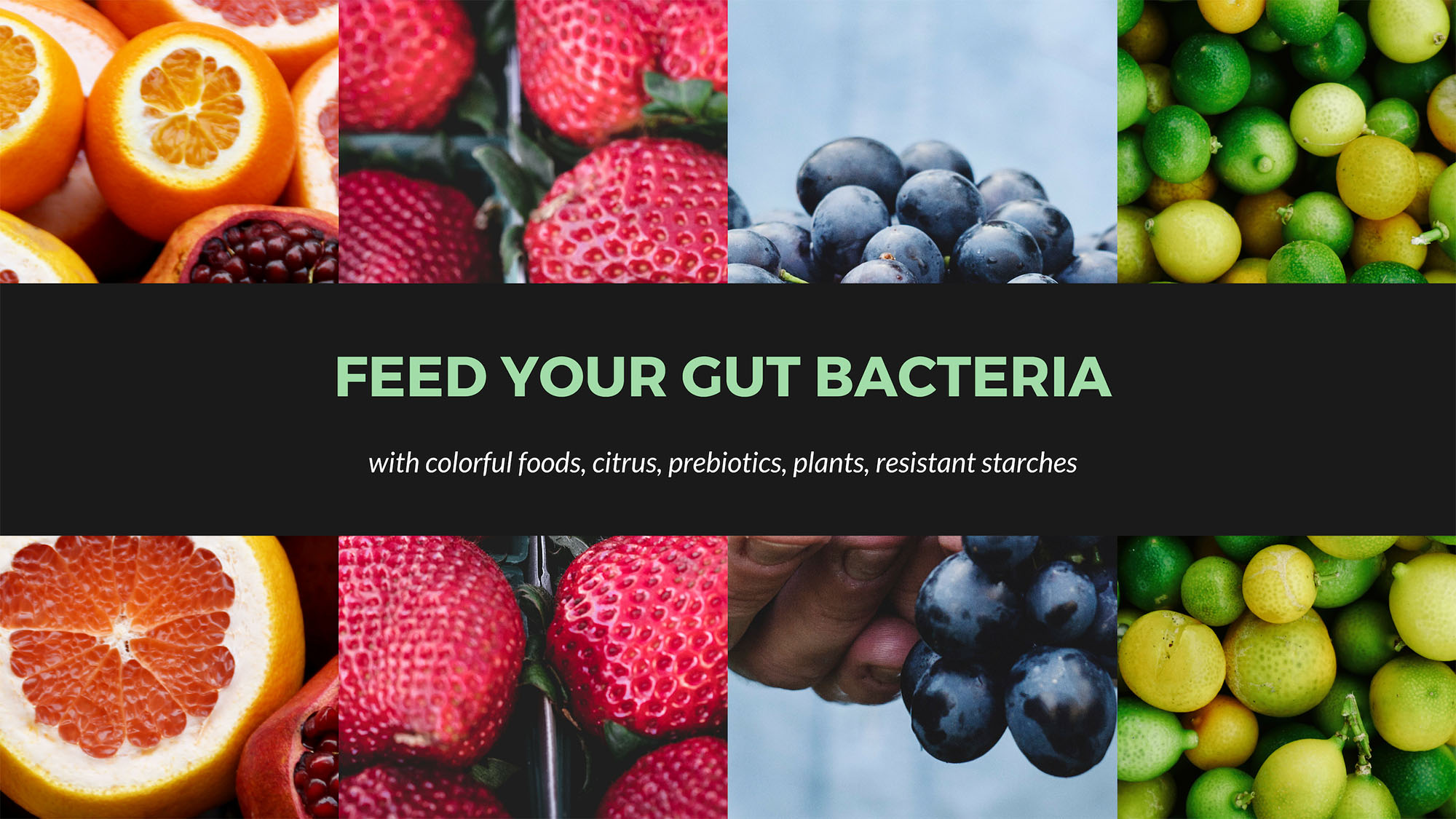Feed Your Gut Bacteria
Health | February 09, 2019

People (myself included) have talked about supporting gut health, and for many people, that can be very daunting. How am I supposed to “support” a system whose potential I’m only just discovering? Relax; I’ve got you covered! Making sure your digestion runs optimally by supporting your gut is as easy as 1-2-3. And the keyword here is feed.
Living in the gut are trillions of bacteria made up of different species and sizes. With bacteria, it’s about quality over quantity. While having enough is definitely important, we also need to make sure we aren’t supporting the wrong kinds that can wreak all sorts of havoc. And to do that is to simply consume the right kinds of foods.
Opportunistic bacteria (as well as yeasts like Candida Albicans) are hungry for one main fuel source: sugar. They crave it so much that they’ll even manipulate us into giving it to them. You read that correctly. Bacteria can influence our cravings, making us reach for sweet things like candies and desserts so that they can have their fix. With bacteria, we’re not just eating for us- we’re eating for two. Or, make that trillions. [1]
So what do our good bacteria desire? I’ll give you a hint. It starts with the letter “F”, makes bowels regular, and is something I’ve recently gone over in my gut health series.
Did you get it? If you guessed FIBER, then you’re right on the money! (Sorry, bacteria!)
Our bacteria love to eat fiber, and as long as they continue to receive enough, they’ll have all the more reason to stay and perform their magic. (Which is everything from helping us to maintain a healthy weight to keeping our immune system strong.) [2]
And here’s what happens when they don’t get enough: their population starts dwindling, as they no longer have any reason to stick around and make house. That leaves the gut with open real estate for opportunistic bad bacteria, yeasts, and parasites to move into. And once those guys become the predominant inhabitants of our gut, we’re in for a downward spiral of declining health. If that’s not enough to scare you, here’s something truly nightmarish and straight out of a horror movie: our starved bacteria will start to eat away at the protective mucus that lines the walls of our intestines. Notice I used the wordprotective. That wall is meant to shield the gut and our bacteria from foreign invaders and toxins like heavy metals, recycled hormones, and undigested food particles. If the wall is being eaten away, those things seep in and irritate the gut. We’re then under extreme inflammation that can quickly spread like wildfire throughout the rest of the body. We’ll be left vulnerable to a variety of pathogens, and fall ill to serious infections.
The following study sums it best:
“We show that during chronic or intermittent dietary fiber deficiency, the gut microbiota resorts to host-secreted mucus glycoproteins as a nutrient source, leading to erosion of the colonic mucus barrier. Dietary fiber deprivation, together with a fiber-deprived, mucus-eroding microbiota, promotes greater epithelial access and lethal colitis by the mucosal pathogen, Citrobacter rodentium….” [3]
OK, if that didn’t make sense to you, here it is in simpler terms:
The study shows that when there isn’t enough fiber to feed bacteria, they’ll eat away at the mucus that lines the barrier of our gut. The eroded barrier combined with a lack of fiber increases the chance of developing a deadly form of inflammation caused by pathogens.
Is that not insane?
Now that we know the risk of starving our bacteria, the next step is to focus on keeping them well fed. As I mentioned before, FIBER is key. But it can’t just be from a supplement.
First of all, a supplement is meant to cover any holes left by an otherwise healthy diet. It’s not the bulk of healthy eating; it’s the extra “boost” to enhance it. You don’t necessarily need it.
Secondly, bacteria respond to different types and sources of fiber. Consuming a fiber supplement like Psyllium Husk or BeneFiber only feeds a small number of strains (or species) of bacteria, when we really out to be fostering a variety.
Rather than sticking to a supplement, look at your diet and consume an assortment of fiber-rich foods. The more variety of foods, the more diverse your population of good bacteria will be.
These foods include:
- Prebiotics: Think of them like fiber with superpowers. Prebiotics are especially potent because they contain special types of fiber like Inulin, FOS, or GOS. Prebiotic-rich foods include asparagus, garlic, leeks, onion, lentils, dandelion, banana, chicory, and artichokes. [4]
- Gelatinous Foods: Ever eaten something slimy? These are foods that, when cooked or soaked, become “gelatinous”. You can find them in chia and flax seeds, nopal cactus, asparagus, and okra.
Fun fact: Collagen or gelatin-, which can either be supplemented or consumed in foods, like bone broth and bone marrow- actually has a prebiotic-like effect on gut bacteria! While it doesn’t exactly match the power of other fibrous foods, it’s still very beneficial, and can nourish your gut bugs to an extent. [5] - Colorful Foods: Let your eyes guide you to these types of gut fertilizers! These foods contain fiber along with special antioxidant compounds like polyphenols that bacteria feed upon in a similar way that they do with prebiotics. Look for them in foods like berries, red onions, dragon fruit (pitaya), matcha green tea powder, red wine, tomatoes, purple asparagus, red leaf lettuce, purple potatoes/sweet potatoes, red cabbage, pomegranates, red chard, and bell peppers. [6] I’d also like to give an honorable mention to raw cacao (chocolate), which has been shown to feed good bacteria as well as provide a slew of antioxidants to the body. Score! [7]
- Citrus: Not just for vitamin c, citrus fruits also contain a type of fiber known as pectin, which acts as a prebiotic for our gut bugs. Citrus tends to be available year-round, so look for it in fruits like lemons and limes, grapefruit, oranges, and pomelo. [8]
- Resistant Starch: This type of starch is very unique because it isn’t fully digested when we consume it. It “resists” digestion and is instead broken down by our friendly bacteria, which convert it into beneficial short-chain fatty acids. (These acids by the way help to lower inflammation, fight off invasive bacteria, and nourish the lining of our intestines to keep it strong and secure.) [9] Resistant Starch foods have been shown to improve insulin sensitivity, lower blood sugar level, and keep us full and satisfied after meals. [10] You can find it in cooked and cooled legumes, Jerusalem artichokes, potatoes/sweet potatoes, rice, squash, unripe/green bananas, plantains, and cashews.
- Plants: You really can’t go wrong with plants in general. Keto, low carb, vegan, vegetarian- every group agrees that having plants from vegetables, fruits (in varying amounts), and nuts and seeds is a good thing. As long as there’s fiber, your bacteria don’t really care!
Sources:
[1] https://chriskresser.com/do-gut-microbes-control-your-food-cravings/
[2] https://www.sciencedaily.com/releases/2013/09/130916122214.htm
[3] https://www.ncbi.nlm.nih.gov/pubmed/27863247
[4] https://www.mayoclinic.org/healthy-lifestyle/consumer-health/expert-answers/probiotics/faq-20058065
[5] http://www.ncbi.nlm.nih.gov/pubmed/22642160
[6] https://www.nutraingredients-usa.com/Article/2016/11/21/Time-is-ripe-for-polyphenols-as-prebiotics-expert-says
[7] https://www.ncbi.nlm.nih.gov/pubmed/15462126
[8] https://www.ncbi.nlm.nih.gov/pubmed/29029078
[9] https://www.healthline.com/nutrition/short-chain-fatty-acids-101
[10] https://www.healthline.com/nutrition/resistant-starch-101














Private Member |
Nice post. Thank you for all the information and I’m always super grateful for food examples like you posted! I’ve been dealing with an out-of-whack gut flora lately and would like to add that sometimes you need to work on reducing the amount of bad bacteria in your gut before strengthening the good ones, or else the bad ones are just going to fight the good ones. It’s much more efficient to reduce the bad bacteria, and THEN work on rebuilding an environment for the good guys.